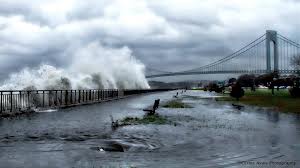Hurricane Sandy made itself felt in the Caribbean as a Category 1 storm that moved through the region dumping rain, lashing out with high winds, and causing the deaths of more than 40 people. After leaving the Caribbean, however, a unique set of conditions and interactions with other weather systems and the jet stream allowed the storm to stay powerful and become a “post tropical cyclone” with New England in its crosshairs. The news media have dubbed Sandy the “Frankenstorm” both for its proximity to Halloween as well as for the unprecedented combination of factors that made the storm possible.
‘Sandy ‘as a hazard
Hazard may be defined as “A dangerous condition or event, that threat or have the potential for causing injury to life or damage to property or the environment.” Hurricane sandy is a hazard which was caused of natural phenomena.
it’s freezing cold and flooded. Hurricane Sandy was a huge natural disaster and has completely changed forever, if not ruined, hundreds of peoples’ lives. Hurricane Sandy affected most of the eastern United States (especially the coastal Mid-Atlantic States), Bermuda, eastern Canada.
Vulnerability of New York City
Vulnerability may be define as “The extent to which a community, structure, services or geographic area is likely to be damaged or disrupted by the impact of particular hazard on account of their nature, construction and proximity to hazardous terrain or a disaster prone area.”
Physical Vulnerability
New York County is the most densely populated county in the United States, and one of the most densely populated areas in the world, with a 2010 population of 1,585,873 living in a land area of 22.96 square miles (59.5 km2), or 69,464 residents per square mile (26,924/km), more dense than any individual American city. It is also one of the wealthiest counties in the United States, with a 2005 per capita income above $100,000. Manhattan is the third-largest of New York’s five boroughs in population, and its smallest borough in land area.
NEW YORK — Subways started running again in much of New York City on Thursday for the first time since Superstorm Sandy, but traffic at bridges backed up for miles, long lines formed at gas stations, and big crowds waited impatiently for buses.The road almost under water.
Three days after Sandy slammed the mid-Atlantic and the Northeast, New York and New Jersey struggled to get back on their feet, the U.S. death toll climbed to more than 80, and more than 4.6 million homes and businesses were still without power.
It include includes notions of who and what may be damaged or destroyed by natural hazard. The hurricane caused killed at least 131 people in eight states, including 53 in New York, 37 in New Jersey, 13 in Pennsylvania, 11 in Maryland, six in West Virginia, five in Connecticut and three each in Virginia and North Carolina. This makes Sandy the deadliest hurricane to hit the United States mainland since Hurricane Katrina in 2005, as well as the deadliest hurricane to hit the U.S. East coast since Hurricane Diane in 1955.
Flights took off and landed Thursday at LaGuardia Airport, the last of the three major New York-area airports to reopen since the storm.
In the morning, more than 1,000 people waited outside an arena in Brooklyn for buses to Manhattan. When one bus pulled up, passengers rushed the door. A transit worker banged on a bus window and yelled at people on the bus and in line.
With the electricity out and gasoline supplies scarce, many stations across the metropolitan area closed, and the stations that were open drew long lines of cars that spilled out onto roads.
Socio –economic Vulnerability
The degree to which a population is affected by a hazard will not merely lie in the physical components of vulnerability but also on the socioeconomic conditions. The socioeconomic condition of the people also determines the intensity of the impact. A total of 24 U.S. states were in some way affected by Sandy. The hurricane caused tens of billions of dollars in damage in the United States, destroyed thousands of homes, left millions without electric service.
In New Jersey, where large swaths of the coastline lay in ruins, some residents finally got a look at what was left of their homes. Sandy wrecked houses, businesses and boardwalks.
The death toll in New York City alone was close to 40. Police on Thursday said two brothers, ages 2 and 4, who were swept away Monday night when waves of water crashed into an SUV driven by their mother in Staten Island were found dead.
The storm underlines the fragility of the aging American infrastructure, with an electricity network that is ranked lower than that of considerably poorer nations like Slovenia or Portugal. The New York Stock Exchange and Nasdaq reopened on October 31, 2012 after a two-day closure for storm.
In the New York city October 27, major carriers canceled all flights into and out of JFK, LaGuardia, and Newark-Liberty airports, and the Metro North and Long Island Rail Roads suspended service. The Tappan Zee Bridge was closed, and later the Brooklyn Battery Tunnel and Holland Tunnel were also closed. On Long Island, an evacuation was ordered for South Shore, including areas south of Sunrise Highway, north of Route 25A, and in elevations of less than 16 feet (4.9 m) above sea level on the North Shore. In Suffolk County, mandatory evacuations were ordered for residents of Fire Island and six towns. Most schools closed in Nassau and Suffolk counties on October 29.
Sea water flooded the Ground Zero construction site. In addition, a four story Chelsea building’s facade crumbled and collapsed.
Gas shortages throughout the region led to an effort by the U.S. federal government to bring in gasoline and set up mobile truck distribution at which people could receive up to 10 gallons of gas, free of charge. This caused lines of up to 20 blocks long and was quickly suspended. On Thursday, November 8, Mayor Bloomberg announced odd-even rationing of gasoline would be in effect beginning November 9 until further notice.
The storm severely damaged or destroyed around 100,000 homes on Long Island with more than 2,000 homes deemed uninhabitable there.
Hurricane Sandy underlines global threat of climate Change
It’s easy to say that “climate change is present in every single meteorological event.” As
Hurricane Sandy began as a low pressure system which developed sufficient organized convection to be classified as a tropical depression. Low wind shear and warm waters allowed for strengthening, and the system was named Tropical Storm Sandy. the NHC upgraded Sandy to hurricane status about 65 mi (105 km) south of Kingston, Jamaica. At about 1900 UTC that day, Sandy made landfall near Kingston with winds of about 80 mph (130 km/h).[18] Just offshore Cuba, Sandy rapidly intensified to winds of 110 mph (175 km/h), and at that intensity it made landfall just west of Santiago de Cuba at 0525 UTC. After Sandy exited Cuba, the structure became disorganized, and it turned to the north-northwest over the Bahamas. Sandy made landfall about 5 miles (8 km) southwest of Atlantic City, with winds of 90 mph (150 km/h). The remnants weakened over western Pennsylvania.
Relation to global warming
There are several areas in which greenhouse-driven warming is thought to be a potential influence. The first is in the buildup of heat in southern surface waters
All weather events are affected by climate change because the environment in which they occur is warmer and moister than it used to be. the “immediate cause” of Sandy to “little more than the coincidental alignment of a tropical storm with an extra tropical storm. “Natural variability “is also responsible for the devastating Sandy.
One factor contributing to the storm’s strength was additional energy from abnormally warm water off the North American East Coast, where global warming was identified as contributing 0.6°C of the 3°C above normal sea surface temperatures. As the temperature of the atmosphere increases, the capacity to hold water increases, leading to stronger storms and higher rainfall amounts. Atlantic hurricanes typically are blown to the east and out to sea by the jet stream’s prevailing winds. In Sandy’s case, this typical pattern was blocked by a ridge of high pressure over Greenland resulting in a negative North Atlantic Oscillation, forming a kink in the jet stream, causing it to double back on itself off the East Coast. Sandy was caught up in this northwesterly flow. The blocking pattern over Greenland also stalled an arctic front which combined with the cyclone.
To human-driven climate change are focused on the impact of reduced Arctic sea ice on Northern Hemisphere weather patterns. Jennifer Francis of Rutgers and Judith Curry of the Georgia Institute of Technology are among researchers who’ve reported evidence of links between open Arctic waters in summer and more turbulent winters (although both say it’s still uncertain where around the Northern Hemisphere the rougher weather will be focused after an ice-reduced summer).
The jet stream pattern — particularly the strongly negative NAO [North Atlantic Oscillation] and associated blocking — that has been in place for the last 2 weeks and is projected to be with us into next week is exactly the sort of highly amplified (i.e., wavy) pattern that I’d expect to see more of in response to ice loss and enhanced Arctic warming. Blocking happens naturally, of course, but it’s very possible that this block may have been boosted in intensity and/or duration by the record-breaking ice loss this summer. Late-season hurricanes are not unheard of either, but Sandy just happened to come along during this anomalous jet-stream pattern, as well as during an autumn with record-breaking warm sea-surface temperatures off the US east coast. It could very well be that general warming along with high sea-surface temperatures have lengthened the tropical storm season, making it more likely that a Sandy could form, travel so far north, and have an opportunity to interact with a deep jet-stream trough associated with the strong block, which is steering it westward into the mid-Atlantic. While it’s impossible to say how this scenario might have unfolded if sea-ice had been as extensive as it was in the 1980s, the situation at hand is completely consistent with what I’d expect to see happen more often as a result of unabated warming and especially the amplification of that warming in the Arctic.
Relation to sea level
The sea surface temperatures along the coast are 5 degrees F. or more above average and 1 degree F. is from global warming. Stronger storm and more precipitation results
Measured sea level at New York and along the New Jersey coast has increased by nearly a foot over the last hundred years. Climatologist Michael E. Mann attributes at least one foot of the 13-foot storm surge in Lower Manhattan to global sea level rise. Harvard geologist Daniel P. Schrag calls Hurricane Sandy’s 13-foot storm surge an example of what will, by mid-century, be the “new norm on the Eastern seaboard”.
A satellite image of the storm on October 29, with most of the U.S. coastline artificially highlighted. The entire east coast is visible, with a cloudless Florida coast seen at the bottom of the image and the outline of the coast of Maine at the top right.
The East River overflowed its banks, flooding large sections of Lower Manhattan. Battery Park had a water surge of 13.88 ft. Seven subway tunnels under the East River were flooded. The Metropolitan Transportation Authority said that the destruction caused by the storm was the worst disaster in the 108-year history of the New York City subway system. Also beach erosion is the main fact for the hurricane.
MITIGATION
A major storm known as hurricane Sandy barrels up East Coast and is predicted to collide with two other storm systems to form “a perfect storm”. As Sandy reaches the conversion point with these two other storms, it becomes clear that it will make landfall in the most populated areas of the nation. Coastal areas of the Northeast including Philadelphia, New York City and New Jersey are in the direct path of the predicted landfall.
The aftermath of the storm is nothing short of devastation. The damage done in New York City alone rivals that of September 11, 2001. Yet the loss of life remains minimal because of actions taken by local government officials prior to the storm making landfall.
Good decisions and actions were made possible in the pre-storm phase because of solid predictive evidence and what I’ll call “techno-intel” – the ability to rely on multiple pieces of technology to provide situational awareness. Local government officials including Mayor Bloomberg from New York City and Mayor Christie from
Perhaps one of the most important pre-landfall actions of the hurricane Sandy event was a consistent nature of the warnings given by the local government officials. I believe that because these messages were consistent, clear (blunt), and described the actions to be taken by the population, the loss of life has been kept to minimum.
Another key factor in the storm response is the protection of infrastructure. Mayor Bloomberg ordered mass transit shutdown well ahead of the landfall hurricane Sandy. This action reinforced to the public evacuation orders must be followed within a given period of time and allowed for vehicles such as buses and subway trains to be sheltered and serviced. Getting mass transportation vehicles to shelters where they could be prepared for a return to service after the storm would allow them to be used in the recovery phase.
Local government officials have listened to the experts and taken an all hazards approach to preparedness with good planning and execution. As of today it seems the residual impact from this “super storm” will be contained to an absolute minimum.
The truth is that wet and continued damp conditions will propagate mold. The penetration level of water and how long it remains in the home is a critical part of the evaluation. Mitigation is the most important issue. Addressing the health issues related to mold are paramount, specifically if you suspect having to wait days before an insurance adjuster becomes available to review your property. Take as many photos of your conditions as possible but do not neglect the primary issue of getting the water out! Pump out the below grade environment as needed, eliminate standing water and proceed with the necessary damage control. Food sources for mold are simple. Paint, paper, plaster and wood are all food sources for mold and mildew. Fabrics are one of the most susceptible because of their ability to hold moisture. Carpet, furniture and in some cases clothing, should be discarded as soon as possible. Depending upon the level of flood waters and the subsequent damage you may be submitting a claim to FEMA as well as to your insurance carrier. It is also important to determine if you have coverage for “contents” under your homeowners flood insurance. FEMA will cover anything that is considered permanently attached to your home. This will include carpet, most kitchen appliances, cabinets, built in book cases, molding and trim around windows and a host of other items.
Mayor Michael Bloomberg said 30,000 to 40,000 New Yorkers may need to be relocated – a monumental task in a city where housing is scarce and expensive – though he said that number will probably drop to 20,000 within a couple of weeks as power is restored in more places.
All other items like personal affects, furniture and electronics should be covered by your homeowner’s policy. However, that coverage is contingent upon the damage resulting from what is called an insured peril. That simply means something else has to happen to cause the interior damage, like a tree falling on the roof allowing the interior space to be exposed. Flood damage is not considered an insured peril under a normal homeowner’s policy which is why flood insurance is separate policy and only available to those whose homes are located in a designated flood zone. Flood insurance as a separate policy should also contain explicit wording about what will be covered. The differences can be staggering if you find yours is incomplete with regard to “contents.” It may dramatically impact your ability to replace all of your pre-storm belongings.
References
- “Tropical Depression Eighteen Discussion Number 1”. Miami, FL: National Hurricane Center. October 22, 2012.
- “Remnants of Sandy Advisory Number 36”. College Park, MD: Hydrometeorological Prediction Center. October 31, 2012.
- UNISDR.
- http://www.mitigationjournal.org/2012/10/hurricane-sandy-setup-for-success/













